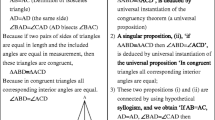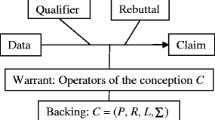Abstract
This paper describes a long term teaching experiment carried out with students from the 9th–10th grades. Geometrical constructions in the Cabri environment were selected as a specific field of experience, within which the sense of theory may emerge. The idea of construction constitutes the key to accessing the idea of theorem, moving from a generic idea of justification towards the idea of validating within a geometrical system. The study aims at clarifying the role of the Cabri environment in this teaching-learning processes: analysis of protocols shows the possible evolution of a justification into a proof but at the same time indicates that this evolution is not expected to be simple and spontaneous.
Similar content being viewed by others
REFERENCES
Balacheff, N. (1987). Processus de preuve et situations de validation. Educational Studies in Mathematics 18(2): 147-176.
Bartolini Bussi, M. (1993). Theoretical and empirical approaches to classroom interaction. In Biehler, Scholz, Strässer and Winckelmann (Eds), Didactic of Mathematics as a Scientific Discipline (pp. 121-132). Dordrecht: Kluwer.
Bartolini Bussi, M. G. (1996). Mathematical Discussion and perspective drawings in Primary School. Education Studies in Mathematics 31: 11-41.
Bartolini Bussi, M. G. (1998). Verbal interaction in mathematics classroom: A Vygotskian analysis. In A. Sierpinska et al. (Eds), Language and Communication in Mathematics Classroom. NCTM.
Boero, P., Dapueto, C., Ferrari, P., Ferrero, E., Garuti, R., Lemut, E., Parenti, L. and Scali, E. (1995). Aspects of the mathematics-culture relationship in mathematics teaching-learning in compulsory school. Proc. of PME-XIX. Recife.
Chazan, D. (1993). High school geometry students' justification for thei views of empirical evidence and mathematical proof. Educational Studies in Mathematics 24: 359-387.
Duval, R. (1992-1993). Argumenter, demontrer, expliquer: Continuité ou rupture cognitive?, Petit x (31): 37-61.
Goldenberg, P. and Cuoco, A. (1998). What is dynamic geometry? In R. Lehrer and D. Chazan (Eds), Designing Learning Environments for Developing Understanding of Geometry and Space. Hilldale, NJ: LEA.
Healy, L. and Hoyles, C. (this issue). Software tools for geometrical problem solving: Potentials and pitfalls. International Journal for Computers in Mathematics Learning.
Heath, T. (1956). The Thirteen Books of Euclid's Elements, Vol. 1. Dover.
Henry, P. (1993). Mathematical machines. In H. Hanken, A. Karlqvist and U. Svedin (Eds), The Machine as Metaphor and Tool (pp. 101-122). Springer-Verlag.
Hoyles, C. and Healy, L. (1999). Linking informal argumentation with formal proof through computer-integrated teaching experiments. In the Proceedings of the Twentythird International Conference for the Psychology of Mathematics Education. Israel: Haifa.
Laborde, C. (1993). The computer as part of the learning environment: The case of geometry. In C. Keitel and K. Ruthven (Eds), Learning from Computers: Mathematics Education and Technology. NATO ASI Series, Springer Verlag.
Leont'ev, A. N. (1981). Problems in the Development of Mind. Moscow: Progress.
Mariotti M. A. (in press). Influence of technologies advances on students' math learning. In L. English et al. (Eds), Handbook of International Research in Mathematics Education. Lawrence Erbaum Associates.
Mariotti M. A. and Fischbein, E. (1997). Defining in classroom activities. Educational Studies in Mathematics 34: 219-248.
Mariotti, M. A. (1998). Introduzione alla dimostrazione all'inizio della scuola secondaria superiore. L'insegnamento della matematica e delle Scienze Integrate 21B(3): 209-252.
Mariotti, M. A. and Bartolini Bussi M. G. (1998). From drawing to construction: teachers mediation within the Cabri environment. Proceedings of the 22nd PME Conference, Vol. I (pp. 180-195). Stellenbosh.
Mariotti, M. A. (1996). Costruzioni in geometria. L'insegnamento della Matematica e delle Scienze Integrate. 19B(3): 261-288.
Mariotti, M. A., Bartolini Bussi, M., Boero P., Ferri F. and Garuti R. (1997). Approaching geometry theorems in contexts: from history and epistemology to cognition. Proceedings of the 21th PME Conference, Vol. I (pp. 180-195). Lathi.
Noss, R. and Hoyles, C. (1996). Windows on Mathematical Meanings. Dordrecht, Netherlands: Kluwer Academic Publishers.
Schoenfeld, A. (1985). Mathematical Problem Solving. New York: Academic Press.
Schoenfeld, A. (1986). On having and using geometric knowledge. In J. Hiebert (Ed), Conceptual and Procedural Knowledge: The Case of Mathematics (pp. 225-263). Hillsdale, NJ: Lawarnce Erlbaum Associates.
Vygotskij L. S. (1978). Mind in Society. The Development of Higher Psychological Processes. Harvard University Press.
Author information
Authors and Affiliations
Rights and permissions
About this article
Cite this article
Mariotti, M.A. Justifying and Proving in the Cabri Environment. International Journal of Computers for Mathematical Learning 6, 257–281 (2002). https://doi.org/10.1023/A:1013357611987
Issue Date:
DOI: https://doi.org/10.1023/A:1013357611987




